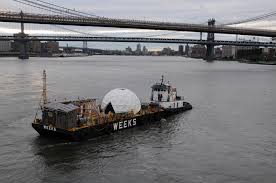

Our artist friend Mary Mattingly often contacts us for technical advice since she is very much interested in wetland and maritime community projects.
Often our involvement with her projects relates to providing her with assistance in finding solutions to floating her projects. (Actual flotation, not the financial kind)
As an artist Mary works with tiny budgets and often the largest cost component relates to the procurement of the float on which the project can be mounted. This blog presents an interesting flotation solution.
The flotation solution to her projects has evolved. For the Waterpod project in New York Harbor, we defaulted to a conventional solution and chartered a deck barge. But at the completion of the project the deck barge had to be returned and the project ended up being dismantled.
Mary’s conceptual work deals with progressive solutions and it would have been very interesting to have an annual Waterpod, which possibly would even become a year round Waterpod. The only way to achieve that would be to own the flotation. But even owning a barge would also run into logistical problems since moving a barge between cities can be quite expensive.

Mary’s next project, Wetlands, was in Philadelphia. We looked at various modular alternatives such as Flexifloats, tubular floats and homebuilt fiberglass covered plywood floats, but all cost more than the budget allowed and Mary instead procured a retired 50 foot houseboat which she pretty much stripped and rebuilt into a very interesting artist’s installation.
All of Mary’s projects focus on reuse and recycling and the reuse of this old houseboat certainly fitted the spirit of the project, but again she was limited in the further use of the project.

For her next project Mary really wanted to engage a modular (transportable) and recycle concept, and from a cost point of view started to drift towards a plywood/fiberglass modular float approach.
About that time, as a container home hobbyist, I saw an article that referred to container houseboats. I saw something different in the article title than the author. When I saw the article title I thought that the article would describe containers used for flotation, while the article actually described container homes mounted on barges.
But now I began to wonder; could containers be used for flotation?
Containers are sort of waterproof, but not really watertight. Especially the bottoms are not really designed to hold water. But the roofs and sides are quite waterproof. What if the containers are floated upside down?
Mary loved the idea and right away started to incorporate the containers in her ideas and even engaged a second hand container supplier to provide her with some costs. This is her preliminary concept and for $15,000 she would pretty much be on the water and ready to mount her project on top.
Mary’s current project is called Swale. The goal of the project is to create a collaborative “floating food forest” for New York City.
Once the vent is closed and the door is welded shut, a container will not sink when it is upside down, but is it safe and cost effective flotation? If it is safe flotation, chances are it will be cost effective. To determine if it is safe flotation will take a little engineering analysis.
This is now an M&O intern project. The following aspects of the project have been considered thus far:
1. Structural Design
2. Lifespan
3. Stability
4. Deployment

